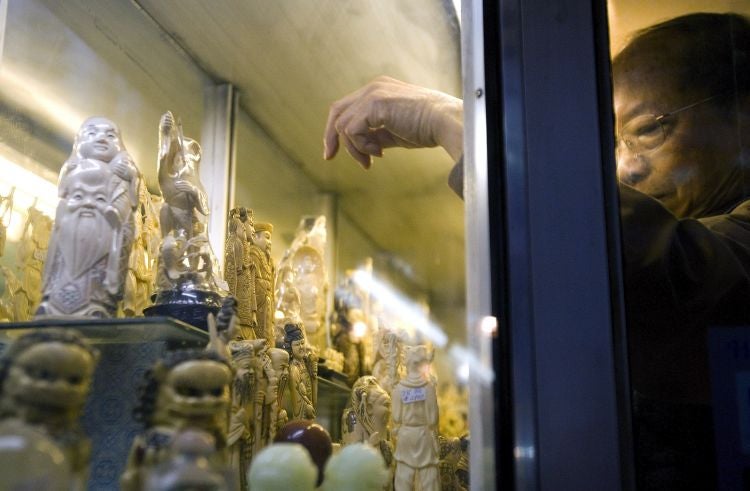The film that stopped the ivory trade
In the late 1980s, Africa’s elephant population was decimated to just 600,000. Bringing the elephant slaughter to consumers' televisions had a profound impact. Can it be done again?

Your support helps us to tell the story
From reproductive rights to climate change to Big Tech, The Independent is on the ground when the story is developing. Whether it's investigating the financials of Elon Musk's pro-Trump PAC or producing our latest documentary, 'The A Word', which shines a light on the American women fighting for reproductive rights, we know how important it is to parse out the facts from the messaging.
At such a critical moment in US history, we need reporters on the ground. Your donation allows us to keep sending journalists to speak to both sides of the story.
The Independent is trusted by Americans across the entire political spectrum. And unlike many other quality news outlets, we choose not to lock Americans out of our reporting and analysis with paywalls. We believe quality journalism should be available to everyone, paid for by those who can afford it.
Your support makes all the difference.Ivory seizures across the world reached a new high in 2013. A hundred elephants died every day for the last 12 months. The elephant death toll has not reached these heights since the 1980s, when the Environmental Investigation Agency brought the issue to light, and caught criminal syndicates red-handed exposing how the trade operated through groundbreaking undercover filming.
As a result, the ivory trade slowed down for 10 years. But with a spurt in demand for ivory from newly affluent Asian consumers, can we squash the ivory trade again?
Mary Rice, now Executive Director of the Environmental Investigation Agency was on the frontline of the conservation movement in late 1980s. At the time, ivory – like fur – was in vogue.
Africa was losing 200 elephants each day to feed demand in America, Europe, Dubai and Hong Kong. Elephant populations halved every ten years, and within a century, Africa’s 3 million elephants had been reduced to a scant population of 600,000.
Rice remembers that buying ivory in the 1970s and 1980s was “acceptable practice.” Though elephant hair bracelets were a popular accessory, “nobody had really made the connection that their bracelet, bangle, billiard balls, key boards were predicated on the death of an elephant.” By 1990, ivory was no longer in style.
She explained how the EIA’s groundbreaking investigative footage of the ivory trade shocked people around the world. Rice said: “Concerns had been flagged over time and alarm bells rung, but no-one was listening. The visual impact of EIA's investigations and films provided the ammunition needed to put forward the ban proposal and to persuade the international community that it was needed.
“Of course, the landscape has completely changed now, but at the time it was a pioneering piece of investigative campaigning – the first time film had been used in such a way.”
For the next decade after the films were released, the ivory trade slowed down and elephant numbers recovered: “The films were instrumental in putting the trade into context and to demonstrate what was actually happening on the ground to the wider public. The evidence was aired on consecutive evenings on ITN news in the run up to the CITES meeting in 1989 and used to lobby decision makers in the lead up to – and during the meeting itself.”
Increasing pressure to stop the ivory trade from the public, coupled with dwindling elephant numbers, gave the impetus to the drvie for an international ban against the ivory trade in 1989. With the ban against poaching in place, elephant populations recovered to one million within ten years.
As elephants thrived, CITES lifted the ban for a “one-off” sale to Japan in 1999. 50 tonnes of ivory from Botswana, Namibia and Zimbabwe were sold to Japan for $5 million (£3 million) - a fraction of their black market price. Following this sale another “one-off” sale took place in 2008 through four auctions in which 102 tonnes of ivory were sold to both China and Japan for $15.4 million (£9.4 million).
With new, cheap ivory flooding the market, demand soared in China and Japan, and poaching African elephants became profitable again.
Rice said that poaching syndicates from the 1980s have reemerged in light of new demand, and she talked about “One particular syndicate which was run by a family, who still have a retail outlet in Hong Kong.”
Poaching was stopped once before. Rice believes it could happen again: “The simple lesson is that if a ban is honoured and implemented, demand drops and people stop buying ivory. It’s not rocket science. As soon as you have a legal market, there will be an opportunity to launder cheaper, illegal goods onto the market place.”
“There is no way to satisfy the current and growing demand. If we continue as we are, we will preside over the extinction of the African elephant; the Asian elephant will likely follow suit. That is not a particularly proud legacy to pass on.”
In 2014, The Independent's elephant campaign supports Space for Giants, a Kenya-based NGO that is working with organisations like the EIA to raise awareness and stop the ivory trade.
Follow our campaign page in the run-up to the government organised conference on 13 February, bringing together heads of state from across the world to find a global solution to wildlife crime once and for all.
Join our commenting forum
Join thought-provoking conversations, follow other Independent readers and see their replies
Comments